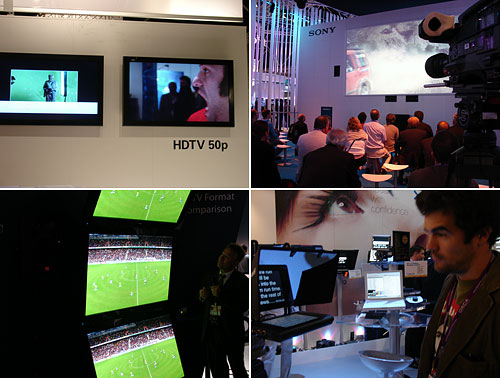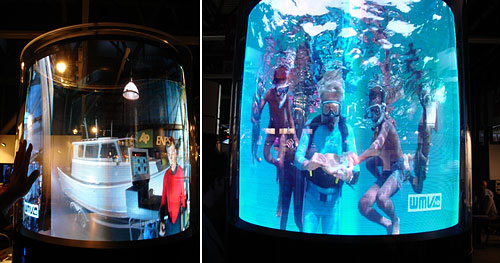

 subscribe
subscribe
It was quite a contrast to step into the IBC salon a week after attending Ars Electronica. The conference boldly calls itself the biggest international broadcasting event, specially since the American NAB has the N instead of an I; it’s national and not international, and it’s 4 times bigger than the biggest international event. It’s the American way. Anyway, IBC 2006 was quite impressive and reaffirmed how the broadcasting world is excited with new technologies emerging as saviours for the old model of doing things. Moreover, the top-up tradition of doing things seams to be falling in love with some interaction trends.
The big star is still HDTV. The novelty that has been running for several years now is still the darling of broadcasting companies; maybe because it is a way they find to distance once again consumers from producers, since it still requires a considerable infrastructure (knowledge and technology) to be crafted. Prosumer cameras have been available in the market for quite a while, but that is far from “proper†HD standards. This year, however, the “peep into the future†was Ultra-HD, with an impressive 4000 lines resolution. I must confess how shock I was with the quality, almost surreal, but for sure very far from being reality.
Mobile television was another spotlight. With networks and producers moving towards digital, watching TV in a PDA or in you car is really simple. However, the convergence of content will require a different approach since it is clear that the relationship consumers have with the old tube is way different than other prospect situations. Targeting that, many companies at IBC focused on showing solutions not necessarily technology-based, but more of a methodological approach. Others are also creating tools to help content creators to edit and publish their ideas; more and more, reporters carry multi-task responsibilities, and now they can, for example, become a one-man broadcasting unit, just by twisting their mobiles (equipped with a camera) to their face, and report live from a site.
An additional highlight, and my personal interest, was IPTV. It is clear the technology is seen differently by companies with distinct backgrounds: broadcasting are relating it to the possibility of distributing more channels on demand, for example, while net-based companies see the potential of social communities growing now with the use of the most beloved item of every household. Although already present in many countries such as Korea, Japan and Italy, IPTV will still face several challenges, being the main one the pipeline for distribution. Since content, which can reach even HD standards, is transmitted over telephone lines, the backbone has to be able to deliver a huge amount of information on demand, meaning, huge, really huge broadband connections. That is still something to worry about, but IP, plus TV, well, definitely sounds good.
Another big hit wasn’t a new technology at all, but China. Companies everywhere are harassing the biggest market in the world, with 400 million TV sets (a third of the world’s spectators). And apparently China isn’t acting like a fool; on the contrary, it’s using its cards the best way possible. With such impressive pressure argument, the Chinese are quickly catching up with TV standards, many times creating new ones of their own, and will pretty soon run against the contemporary standards. In Brazil, digital television was a dispute between European, American and Japanese standards. Maybe in other developing countries, China will be a forth vertex.

An interesting cylinder screen produced by Kinoton: strip of LED spins, creating the illusion of projection over the transparent cylinder. The quality is very impressive, and I’m sure some media artist will find the use for it soon. In the mean time, it remains a luxury for a specific audience, since the cost of a unit is around 30.000 euros.
| Attachment | Size |
|---|---|
| ibc2006_nako_01.jpg | 53.51 KB |
| ibc2006_nako_02.jpg | 49.31 KB |